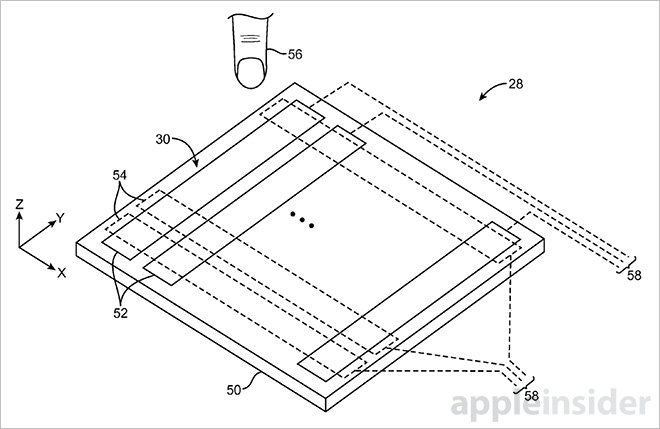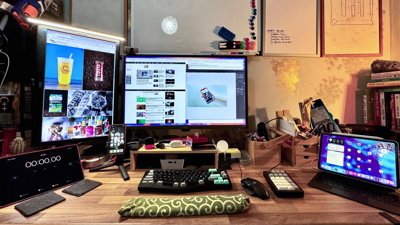An Apple patent application published by the U.S. Patent and Trademark Office on Thursday reveals continued research into alternative energy solutions, specifically as it applies to a lineup of wireless computer peripherals with embedded solar cells.
Like previous Apple inventions dealing with solar charging technology, "Wireless devices with touch sensors and solar cells" describes a device into which solar cells are disposed below transparent touch sensitive surfaces. However, instead of applying the technology to power-hungry portables like iPhone, Apple proposes integration with Bluetooth wireless keyboards, mice, multitouch track pads and other accessories.
In practice, light-based power sources are simply built into the functional top layers of a device. For example, solar cells could be embedded beneath capacitive sensor layers in Apple's Magic Mouse or Magic Trackpad, separated and stabilized by layers of liquid adhesive. During operation, the solar system gathers and converts ambient light into usable electrical energy, which is subsequently stored in a battery system or regulated capacitor. The device would then tap into harvested energy reserves to operate capacitive touch sensors, onboard processors, wireless radios and other components, potentially negating the need for batteries.
Some embodiments call for the solar cell layer to sit beneath both touch sensor and transparent protective cover layers, while others have energy producing elements sandwiched between the touch layer and protective cover. Apple notes orientation depends on material choice, as certain capacitive touch sensor designs inhibit light transmission.
In some iterations, ink or another material might be deposited above the solar cell components to obscure it from the view of a user. These substances would be opaque to visible light, but transparent in non-visible spectrums, perhaps infrared or fluorescent. While narrow, the material's transmission window allows for ambient light to pass through and hit embedded solar cells, allowing for energy conversion and storage. Apple notes visible-light-opaque layers can form brand logos or other aesthetically pleasing designs.
As with any Apple patent application, it is unclear if the company actually has plans to integrate solar technology into its existing peripheral lineup. Current device designs, with multitouch capabilities and transparent casings, are ideal candidates for such alternative energy solutions, though it remains to be seen if solar conversion technology is up to the task of supplying enough energy, and at ample capacities, to facilitate long-term daily use.
Apple has been researching solar tech for years. Patent filings related to solar-assisted iPod and iPhone recharging date back to 2008, while more recent applications show advanced designs involving device display stack-ups and high-power configurations capable of powering a MacBook.
Last year, The New York Times reported Apple was eyeing solar or wireless inductive charging for its Apple Watch product, then dubbed "iWatch" by media outlets. The company ultimately opted for the latter, though future Watch versions could potentially incorporate some type of light-to-energy conversion technology, at least to help lighten the load on internal battery cells.
Apple's solar-powered computer peripheral patent application was first filed for in January 2014 and credits Matthew E. Lang as its inventor.
 Mikey Campbell
Mikey Campbell









-m.jpg)






 Christine McKee
Christine McKee
 Malcolm Owen
Malcolm Owen

 Sponsored Content
Sponsored Content

 Amber Neely
Amber Neely











13 Comments
Not a lot of solar power inside an office building. Or anywhere in my house where my Macs are located.
I hope they can be powered by LED monitor light, I work in almost darkness!
Non-visible "fluorescent" spectrum? That's a new one.
[quote name="muppetry" url="/t/187231/apple-investigating-solar-powered-wireless-mice-and-trackpads#post_2748851"]Non-visible "fluorescent" spectrum? That's a new one.[/quote] Ha yeah, any efficient internal lighting gives out as little non-visible light as possible, since anything else is a waste of energy. I don't doubt Apple's experimented with solar, but considering the terrible efficiency of solar panels it's most likely turned out to be a waste of time. Maplins in the UK sell a solar panel that's about a foot square and it's still only 3.5w. Based on the iPhone's battery life (~24h) and its battery capacity (~6w) it's a continual drain of about 0.2 watts, which seems reasonable. But considering an iPhone charges very slowly from a standard 2.5w USB socket I don't hold out much hope for an iPhone sized panel. Also... [quote name="AppleInsider" url="/t/187231/apple-investigating-solar-powered-wireless-mice-and-trackpads#post_2748834"]During operation, the solar system gathers and converts ambient light into usable electrical energy, which is subsequently stored in a battery system or regulated capacitor. The device would then tap into harvested energy reserves to operate capacitive touch sensors, onboard processors, wireless radios and other components, potentially negating the need for batteries. [/quote] "Stored in a battery system or capacitor ... potentially negating the need for batteries" Right, store energy in a battery without one. In any case, what happens in the dark with no batteries? A capacitor is useless as a long term storage device, the energy to size ratio is pretty awful for a start. Do you have any idea what you're writing about AI? :no:
[quote name="Elijahg" url="/t/187231/apple-investigating-solar-powered-wireless-mice-and-trackpads#post_2748864"] Ha yeah, any efficient internal lighting gives out as little non-visible light as possible, since anything else is a waste of energy. I don't doubt Apple's experimented with solar, but considering the terrible efficiency of solar panels it's most likely turned out to be a waste of time. Maplins in the UK sell a solar panel that's about a foot square and it's still only 3.5w. Based on the iPhone's battery life (~24h) and its battery capacity (~6w) it's a continual drain of about 0.2 watts, which seems reasonable. But considering an iPhone charges very slowly from a standard 2.5w USB socket I don't hold out much hope for an iPhone sized panel. Also... "Stored in a battery system or capacitor ... potentially negating the need for batteries" Right. What happens in the dark with no batteries? A capacitor is useless as a long term storage device, the energy to size ratio is pretty awful for a start. Do you have any idea what you're writing about AI? :no:[/quote] I've an idea, the heat that comes of the pair of 27" Apple LCD monitors I sit in front of could probably power a steam turbine electric generator ;)